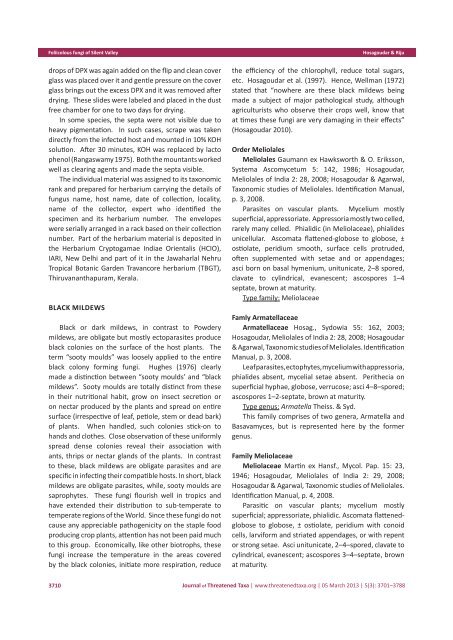PDF - Journal of Threatened Taxa
PDF - Journal of Threatened Taxa
PDF - Journal of Threatened Taxa
Create successful ePaper yourself
Turn your PDF publications into a flip-book with our unique Google optimized e-Paper software.
Foliicolous fungi <strong>of</strong> Silent Valleydrops <strong>of</strong> DPX was again added on the flip and clean coverglass was placed over it and gentle pressure on the coverglass brings out the excess DPX and it was removed afterdrying. These slides were labeled and placed in the dustfree chamber for one to two days for drying.In some species, the septa were not visible due toheavy pigmentation. In such cases, scrape was takendirectly from the infected host and mounted in 10% KOHsolution. After 30 minutes, KOH was replaced by lactophenol (Rangaswamy 1975). Both the mountants workedwell as clearing agents and made the septa visible.The individual material was assigned to its taxonomicrank and prepared for herbarium carrying the details <strong>of</strong>fungus name, host name, date <strong>of</strong> collection, locality,name <strong>of</strong> the collector, expert who identified thespecimen and its herbarium number. The envelopeswere serially arranged in a rack based on their collectionnumber. Part <strong>of</strong> the herbarium material is deposited inthe Herbarium Cryptogamae Indiae Orientalis (HCIO),IARI, New Delhi and part <strong>of</strong> it in the Jawaharlal NehruTropical Botanic Garden Travancore herbarium (TBGT),Thiruvananthapuram, Kerala.Black mildewsBlack or dark mildews, in contrast to Powderymildews, are obligate but mostly ectoparasites produceblack colonies on the surface <strong>of</strong> the host plants. Theterm “sooty moulds” was loosely applied to the entireblack colony forming fungi. Hughes (1976) clearlymade a distinction between “sooty moulds’ and “blackmildews”. Sooty moulds are totally distinct from thesein their nutritional habit, grow on insect secretion oron nectar produced by the plants and spread on entiresurface (irrespective <strong>of</strong> leaf, petiole, stem or dead bark)<strong>of</strong> plants. When handled, such colonies stick-on tohands and clothes. Close observation <strong>of</strong> these uniformlyspread dense colonies reveal their association withants, thrips or nectar glands <strong>of</strong> the plants. In contrastto these, black mildews are obligate parasites and arespecific in infecting their compatible hosts. In short, blackmildews are obligate parasites, while, sooty moulds aresaprophytes. These fungi flourish well in tropics andhave extended their distribution to sub-temperate totemperate regions <strong>of</strong> the World. Since these fungi do notcause any appreciable pathogenicity on the staple foodproducing crop plants, attention has not been paid muchto this group. Economically, like other biotrophs, thesefungi increase the temperature in the areas coveredby the black colonies, initiate more respiration, reduceHosagoudar & Rijuthe efficiency <strong>of</strong> the chlorophyll, reduce total sugars,etc. Hosagoudar et al. (1997). Hence, Wellman (1972)stated that “nowhere are these black mildews beingmade a subject <strong>of</strong> major pathological study, althoughagriculturists who observe their crops well, know thatat times these fungi are very damaging in their effects”(Hosagoudar 2010).Order MeliolalesMeliolales Gaumann ex Hawksworth & O. Eriksson,Systema Ascomycetum 5: 142, 1986; Hosagoudar,Meliolales <strong>of</strong> India 2: 28, 2008; Hosagoudar & Agarwal,Taxonomic studies <strong>of</strong> Meliolales. Identification Manual,p. 3, 2008.Parasites on vascular plants. Mycelium mostlysuperficial, appressoriate. Appressoria mostly two celled,rarely many celled. Phialidic (in Meliolaceae), phialidesunicellular. Ascomata flattened-globose to globose, ±ostiolate, peridium smooth, surface cells protruded,<strong>of</strong>ten supplemented with setae and or appendages;asci born on basal hymenium, unitunicate, 2–8 spored,clavate to cylindrical, evanescent; ascospores 1–4septate, brown at maturity.Type family: MeliolaceaeFamly ArmatellaceaeArmatellaceae Hosag., Sydowia 55: 162, 2003;Hosagoudar, Meliolales <strong>of</strong> India 2: 28, 2008; Hosagoudar& Agarwal, Taxonomic studies <strong>of</strong> Meliolales. IdentificationManual, p. 3, 2008.Leaf parasites, ectophytes, mycelium with appressoria,phialides absent, mycelial setae absent. Perithecia onsuperficial hyphae, globose, verrucose; asci 4–8–spored;ascospores 1–2-septate, brown at maturity.Type genus: Armatella Theiss. & Syd.This family comprises <strong>of</strong> two genera, Armatella andBasavamyces, but is represented here by the formergenus.Family MeliolaceaeMeliolaceae Martin ex Hansf., Mycol. Pap. 15: 23,1946; Hosagoudar, Meliolales <strong>of</strong> India 2: 29, 2008;Hosagoudar & Agarwal, Taxonomic studies <strong>of</strong> Meliolales.Identification Manual, p. 4, 2008.Parasitic on vascular plants; mycelium mostlysuperficial; appressoriate, phialidic. Ascomata flattenedgloboseto globose, ± ostiolate, peridium with conoidcells, larviform and striated appendages, or with repentor strong setae. Asci unitunicate, 2–4–spored, clavate tocylindrical, evanescent; ascospores 3–4–septate, brownat maturity.3710<strong>Journal</strong> <strong>of</strong> <strong>Threatened</strong> <strong>Taxa</strong> | www.threatenedtaxa.org | 05 March 2013 | 5(3): 3701–3788

















